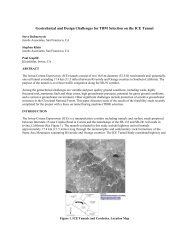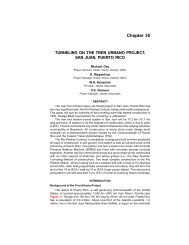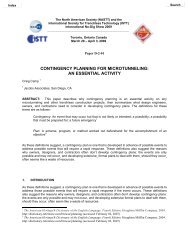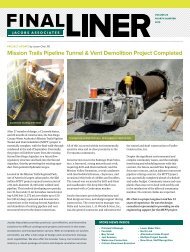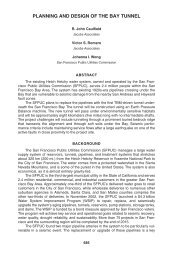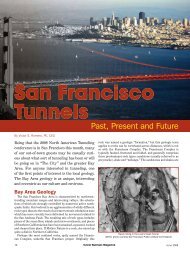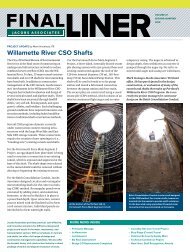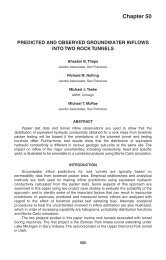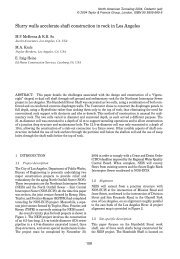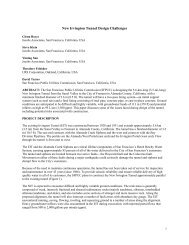Riverside Badlands Tunnel, Inland Feeder Project - Jacobs Associates
Riverside Badlands Tunnel, Inland Feeder Project - Jacobs Associates
Riverside Badlands Tunnel, Inland Feeder Project - Jacobs Associates
You also want an ePaper? Increase the reach of your titles
YUMPU automatically turns print PDFs into web optimized ePapers that Google loves.
998 2003 RETC PROCEEDINGS<br />
developed. Low density cellular concrete (LDCC) was specified as a backfill material<br />
around the pipe to reduce the risk of pipe flotation; facilitate the backfilling long<br />
sections of pipe; and provide corrosion protection for the pipe.<br />
Contracting Approach. The contracting approach developed for the project<br />
allowed the contractor flexibility where possible, subject to certain limitations. Some of<br />
the specific requirements that had to be complied with included:<br />
Positive groundwater control in the alluvium reaches.<br />
Drilling of probe holes and pre-excavation grouting in certain defined intervals<br />
of the tunnel.<br />
Shielded TBM’s were required due to the low strength of the San Timoteo<br />
Formation<br />
Mining operations limited at the Opal Portal to day shift only.<br />
The amount of pre-excavation grouting required was uncertain and this work was<br />
paid for on a force-account basis to minimize the risk to both the owner and contractor.<br />
Other risk management provisions that were incorporated into the Contract included a<br />
GDSR, Disputes Review Board, and Escrow Bid Documents. The time for completion<br />
was increased to about 60 months to allow the contractor the flexibility to excavate the<br />
tunnel from one heading or multiple headings.<br />
CONSTRUCTION PHASE<br />
The project was bid in 1998 and the Contract awarded to a joint venture of Shank/<br />
Balfour Beatty (SBB) for $113 million, which included a $5 million allowance for probe<br />
drilling and pre-excavation grouting. Construction began in October of 1998 with the<br />
excavation of the Gilman Portal and dewatering work at the two intermediate shafts.<br />
<strong>Tunnel</strong> excavation was carried out from November 1999 through July 2001.<br />
<strong>Tunnel</strong> Construction Approach<br />
The main tunnel staging area was established at the Gilman Portal and all<br />
tunneling operations and the majority of the pipe installation activities were carried out<br />
from this site. The two optional intermediate shafts, at San Timoteo and Live Oak<br />
Canyons, were used for ventilation, access during tunneling, and access to place the<br />
LDCC backfill. The entire tunnel was mined with the same shielded TBM designed to<br />
handle soft ground, weak rock, and hard rock. Precast concrete segments, 8 inches<br />
thick, were installed for initial support. The 4-segment ring was expanded with<br />
hydraulic jacks as it was pushed out of the tail shield and screw jacks were used to<br />
secure the expanded segment rings.<br />
TBM Description. The TBM was a fully shielded machine designed and<br />
assembled by SBB (Figure 3). Hitachi Zosen manufactured the TBM body and tail<br />
shield. The hydraulically driven cutterhead was configured with 43 cm (17 in) diameter<br />
disc cutters and the machine was advanced with thrust jacks bearing against the<br />
precast concrete segment supports. Muck was removed from the plenum with a 76 cm<br />
(30 in) diameter screw conveyor. Key machine details are provided in Table 3.<br />
TBM Progress Rates. SBB normally employed two mining shifts and a single<br />
maintenance shift 5 days per week. The overall average advance rate for the tunnel<br />
was about 30 m/day (99 ft/day). As indicated in Table 4, the advance rates are even<br />
higher if non-productive days, for grouting and drilling drain holes ahead of the TBM,<br />
are discounted. Making this adjustment increases the average advance rate to about<br />
43 m/day (141 ft/day). Advance rates in Reaches 1, 5, and 6 were particularly<br />
impressive averaging over 60 m/day (200 ft/day) [Table 4]. Figure 4 shows the tunnel



